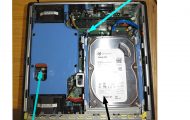Article
Len Deighton’s Bomber, the first book ever written on a word processor. – Slate Magazine
My Comments
Before the arrival of the word processor, whether in today’s office suites that you can buy for your computer or even the basic text editor programs that came with most operating systems, the creation of a novel or other book required a lot of work.
This work was especially in the form of a continuous cycle of typing and reviewing the chapter drafts for that magnum opus. Len Deighton had a few IBM Selectric “golfball” typewriters which he used to work out his manuscripts and his personal assistant was ending up typing the chapter drafts as part of the review cycle for his novels. But in 1968, Eleanor Handley mentioned about this hard work to an IBM technician who worked under contract to this author to service these workhorses for him.
At that time, IBM had just launched the MT/ST which was a Selectric typewriter that worked alongside a tape drive system so the documents can be stored on reels of magnetic tape. The technician mentioned that IBM had this machine that could help him with this and future magnum opuses. He had leased the machine and the delivery men had to remove his front window so they could hoist it in by crane.
The features and tricks that this device had allowed him to review, insert and substitute text for each of the chapters that existed on each reel of tape. He exploited the “marker codes” that could be placed on the tape so he could locate the passages he was working on and this machine came in to play in him writing “Bomber” which was a novel set in World War II.
These devices evolved from the dedicated word-processing machines that worked alongside electronic or, in some cases, electric typewrites to the dedicated computer programs that you bought for most desktop computer systems from the early to mid 1980s.
With the arrival of the Graphic User Interface in 1984 courtesy of the Apple Macintosh, the ability to turn out copy that was hard to distinguish from published copy became a key feature. Here, the computer could draw out the typeface without the printer needing support for that font. As well, the word-processor became part of integrated “office” computing packages that had this function along with database, spreadsheet, presentation / business graphics and email functionality.
For me, the concept of creating a document from “go to whoa” using a computer’s word-processor software rather than handwriting it was a marked change. Here, the time it took to turn out a polished document was significantly reduced and I realised that I could easily work “from mind to document” without “scratching out” text with a black line or “wedging in” text using the caret symbol.
As for novelists and other authors, the amount of time it took to create copy for the paper or electronic destination was significantly reduced and you were able to make sure that the copy was “how you wanted it”.
Similarly the fact that Len Deighton had the MT/ST equipment at his home was a prediction of things to come in the form of desktop and personal computing which came about 10 years later.


